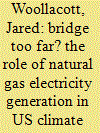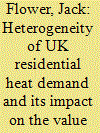| Srl | Item |
| 1 |
ID:
177151


|
|
|
|
|
| Summary/Abstract |
Natural gas has been promoted as a ‘‘bridge’’ fuel toward a low-carbon future by offering near-term emissions reductions at lower cost. Existing literature is inconclusive on the short-term emissions benefits of more abundant natural gas. The long-lived nature of natural gas infrastructure also threatens to lock in emissions levels well above longer-term targets. If natural gas can offer short-to-medium term benefits, how much of a bridge should we build? Using ARTIMAS, a foresighted computable general equilibrium model of the US economy, we interact scenarios developed by the EMF-34 study group related to abundant natural gas, low-cost renewables, and a carbon tax to examine the role of natural gas in a carbon-constrained future. We find that abundant natural gas alone does not have a significant impact on CO2 emissions. We also find that, under a higher carbon tax, natural gas investment of approximately $10 billion per year declines to zero at a tax of about $40/ton and existing natural gas assets face significant risk of impairment. Last, the presence of abundant natural gas lowers the marginal welfare cost of abating small amounts of CO2 but is likely to raise the cost of abatement levels consistent with common climate objectives. The integrated welfare costs of climate policy depend on how much abatement we must undertake.
|
|
|
|
|
|
|
|
|
|
|
|
|
|
|
|
| 2 |
ID:
176891


|
|
|
|
|
| Summary/Abstract |
This study examines the heterogeneity of UK residential heat demand and how this diversity, along with social demographic and dwelling characteristic diversity, impacts the value case for heat pumps (HPs). The marginal abatement cost (MAC) of HPs is highly sensitive to the level of heat demand and technology assumptions. Care must be taken when interpreting the results from models with a high degree of aggregation. For similar dwellings, heat demand typically becomes lower for demographic groups that have higher levels of deprivation. For similar dwellings and demographics, households using natural gas typically have double the end-use heat demands of households with electric storage heaters. Therefore, if access to heating with similar costs to that of natural gas-fired heating is gained, the direct rebound effect suggests that the heat demands of households heated with electric storage heaters could double, particularly for households that have relatively high proportions of energy expenditure. Heating technology and building efficiency support mechanisms need to simultaneously address the wider goal of decarbonisation while reducing fuel poverty, and to incorporate measures of demand diversity into future assessment of heat policy that recognises how this rebound may oppose decarbonisation efforts but enable improvements in comfort, welfare and health standards.
|
|
|
|
|
|
|
|
|
|
|
|
|
|
|
|
| 3 |
ID:
179737


|
|
|
|
|
| Summary/Abstract |
Carbon capture, utilization and storage (CCUS) represents a set of technologies essential to meeting ambitious mid-to late-century decarbonization goals. Yet deployment of CCUS has been slow, with fewer than 20 large-scale facilities operating worldwide in 2019. We estimate the total and marginal cost of constructing and operating new CCUS facilities and associated infrastructure to reduce carbon dioxide (CO2) emissions from current and planned industrial facilities on the Texas and Louisiana Gulf Coast. We compare these cost estimates to scheduled CCUS tax incentives through 2026 under section 45Q of the U.S. Internal Revenue Code to quantify cost-effective emissions abatement. Our analysis measures the cost-reducing potential of economies of scale in regional CO2 pipeline networks. We also compare CCUS costs to one measure of the benefits of carbon capture, the social cost of carbon. Results suggest that U.S. federal tax incentives currently in place through 2026 could justify between 3.3 million and 77.6 million tons of annual CCUS in the Gulf region, depending on the choice of storage technology and the degree of pipeline network coordination. Finally, we highlight several potential policy barriers that may explain low adoption of CCUS in the Gulf Region and elsewhere.
|
|
|
|
|
|
|
|
|
|
|
|
|
|
|
|